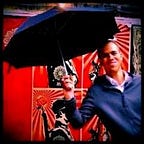How do we take a journey together when we come from different cultures
We know that how society brings up its children is critical to how it shapes itself as a nation — its history, its symbols and its practices. But given that our generation has multiple identities and greater contact with other cultures, what can we learn from experiences of integration — how can we take a journey through life and even through a city with people who haven’t been brought up in the same culture or don’t speak the same language? How can we become a community characterised by the exchange of experience and solidarity.
What can we learn from the different models of integration? By promoting diversity, are we not making our society more individualistic? Is European identity an option? How can we make Europe more accessible, from being able to travel to being able to influence its decisions, to feeling European as well as British? If were to use the six degrees of separation, would we feel more European?
What can we learn from different curriculums and forms of parenting across Europe about how we bring up our children? How can we inspire children to want to discover other cultures through learning languages? What are the shared non-verbal language touchpoints that can help young people from different cultures understand and feel empathy for each other? How can we educate people on how people from other cultures live, so they can see how different reality is from the rhetoric, but also what we may all have in common with what we have to learn from each other?
How did we going to develop this issue?
‘People will be invited to take a journey through London, ideally pairing up with people from other countries*. The participants will be guided on their journey through tailored guidebooks and maps and, pending funding, geotagged technology. They will be given a scrap book where they have to collect examples of imprints of different cultures in the city.
At the end of their journey, they will be welcomed by a flashmob and the opportunity to take part in workshops using non-verbal communications (such as singing, dancing, sign language, drawing). The documentation collected in the scrap book of each participants will be displayed (format to be confirmed) and shared through social media.
We’re going to create the clues with help from other Transeuropa Citygroups and cultural groups in London, develop a workshop in advance of the festival to get designers to work with cultural and migrant groups to design the clues, guidebooks and maps and invite groups from different cultures (i.e. migrant groups, student societies) to propose non-verbal forms of communication that could be used in the workshops.
The main keywords around migration and integration were multiculturalism, language, free movement and asylum seekers. To a lesser extent, borders, displacement and travel also featured.
These two activities were designed following brainstorming of which a summary is below
The main festival techniques people suggested for activities around migration and integration were
o storytelling and performance, followed by
o discussions and workshops
o exhibitions and film programmes
The main ways people wanted to involve others were:
o organizing walks/ tours in the city,
o offering people the opportunity to showcase their work,
o taking part in a flashmob,
o dancing & partying
The activities would be developed by
o creating materials and publications
o research
o developing a film programme
The activities would bring different partners together (researchers, artists, entrepreneurs and local groups).
